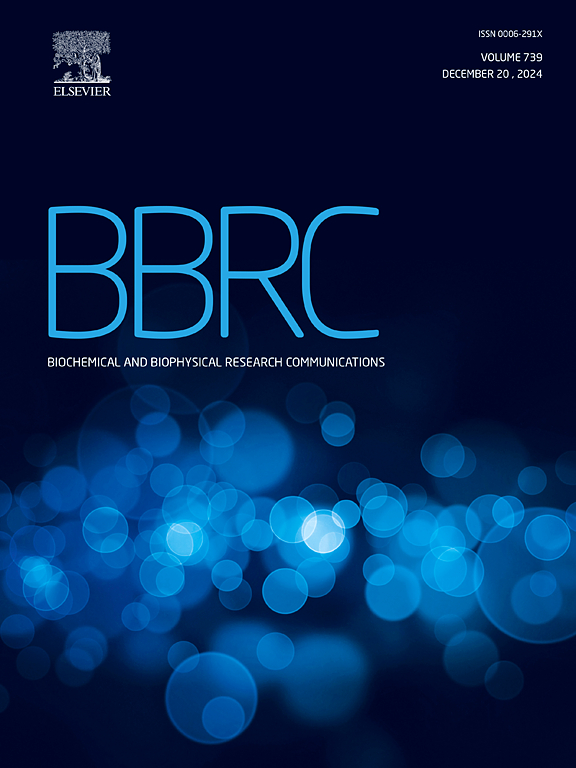IRF2-driven upregulation of OAS3 promotes AML cell proliferation by modulating the JAK-STAT signaling pathway
IF 2.5
3区 生物学
Q3 BIOCHEMISTRY & MOLECULAR BIOLOGY
Biochemical and biophysical research communications
Pub Date : 2025-05-21
DOI:10.1016/j.bbrc.2025.152064
引用次数: 0
Abstract
Acute myeloid leukemia (AML) presents significant treatment challenges due to its heterogeneity and resistance to conventional therapies. This study explored the role of 2′-5′-oligoadenylate synthetase 3 (OAS3) in AML progression and its potential as a prognostic and therapeutic biomarker. Through bioinformatics analysis, OAS3 was found to be significantly upregulated in AML patients and associated with poor clinical outcomes. Functional assays in AML cell lines revealed that silencing OAS3 suppressed cell proliferation, induced G1 phase arrest, and promoted apoptosis, while its overexpression enhanced cell growth. Pathway analysis and western blotting demonstrated that OAS3 regulates the JAK-STAT signaling pathway. Further investigation revealed that interferon regulatory factor 2 (IRF2) acts as a transcription factor that binds to the promoter region of OAS3 and enhances its expression, thereby indirectly modulating the JAK-STAT pathway. Cotransfection experiments with IRF2 and si-OAS3 supported this regulatory mechanism. In vivo studies using a xenograft model and subsequent immunohistochemical analysis of tumor specimens confirmed the role of OAS3 in AML progression. These findings highlight OAS3 as a critical player in AML pathogenesis, functioning through the JAK-STAT pathway activation under the transcriptional control of IRF2. The study suggests that OAS3 could serve as a valuable prognostic marker and therapeutic target, offering a promising avenue to improve AML treatment outcomes.
irf2驱动的OAS3上调通过调节JAK-STAT信号通路促进AML细胞增殖
急性髓性白血病(AML)由于其异质性和对常规治疗的耐药性,提出了重大的治疗挑战。本研究探讨了2 ' -5 ' -低聚腺苷酸合成酶3 (OAS3)在AML进展中的作用及其作为预后和治疗生物标志物的潜力。通过生物信息学分析,我们发现OAS3在AML患者中显著上调,并与较差的临床预后相关。AML细胞系的功能分析显示,沉默OAS3可抑制细胞增殖,诱导G1期阻滞,促进细胞凋亡,而过表达OAS3可促进细胞生长。通路分析和western blotting表明OAS3调控JAK-STAT信号通路。进一步研究发现,干扰素调节因子2 (IRF2)作为转录因子结合OAS3的启动子区域并增强其表达,从而间接调节JAK-STAT通路。IRF2和si-OAS3的共转染实验支持了这一调控机制。使用异种移植模型的体内研究和随后对肿瘤标本的免疫组织化学分析证实了OAS3在AML进展中的作用。这些发现强调了OAS3在AML发病机制中发挥关键作用,在IRF2的转录控制下通过JAK-STAT通路激活发挥作用。该研究表明,OAS3可以作为一个有价值的预后标志物和治疗靶点,为改善AML治疗结果提供了一条有希望的途径。
本文章由计算机程序翻译,如有差异,请以英文原文为准。
求助全文
约1分钟内获得全文
求助全文
来源期刊
CiteScore
6.10
自引率
0.00%
发文量
1400
审稿时长
14 days
期刊介绍:
Biochemical and Biophysical Research Communications is the premier international journal devoted to the very rapid dissemination of timely and significant experimental results in diverse fields of biological research. The development of the "Breakthroughs and Views" section brings the minireview format to the journal, and issues often contain collections of special interest manuscripts. BBRC is published weekly (52 issues/year).Research Areas now include: Biochemistry; biophysics; cell biology; developmental biology; immunology
; molecular biology; neurobiology; plant biology and proteomics

 求助内容:
求助内容: 应助结果提醒方式:
应助结果提醒方式:


